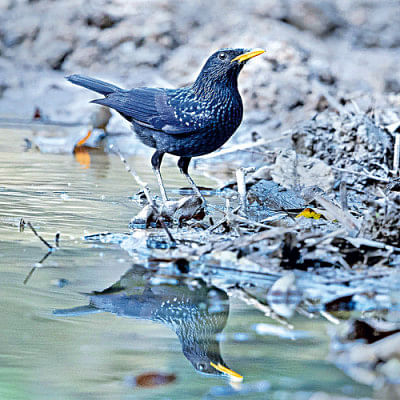Thrush

Thrushes are a family of small to medium-sized songbirds. They spend most of their time on the ground inside forests, picking insects, worms and vegetable matter. There are 172 species of Thrushes spread all over the world, although the most variety is found in Asia and Africa. They vary from five to twelve inches in length and have a characteristic thin bill.
The first Thrush I saw was the Orange-headed Thrush in the National Botanical Garden in Mirpur. I was there on a cloudy monsoon day and not expecting much when I saw a flash of colour under a grove of trees. The bird was rapidly walking in the shade, foraging for food. I was struck by its bright orange head. It moved in and out of bushes with nimble, rapid steps. I carefully stalked it for a picture. This became a difficult task as it was dark underneath the tall trees but I managed a reasonable photo. When it flew, it did so weakly, staying low and landing quickly back on the ground.
The following year, during monsoon, I saw Orange-headed Thrushes – mother and chick - on the walking trail near the lake in Baridhara. The mother loitered mostly on the ground and the chick tentatively followed it. One morning I saw it dig out an earthworm and tenderly feed the chick. I saw them on several other days, mostly on the ground or on low branches, before they disappeared.
It would be some years before I would see a different Thrush. On a trip to Bhutan, I left our hotel in Paro to walk along the banks of the Paro River. On an overhanging wire was perched a bird. I was struck by its rich, dark-blue coat with silver dots and streaks contrasting with a yellow beak. It turned out to be a Blue Whistling Thrush, common in Bhutan.
Since then I have spotted this blue bird in Bangladesh several times. Late one afternoon in Satchori National Park I saw it sitting on an overhead branch. But it was just about sunset and my photograph came out dark. Months later, at a nearby water body, I saw it again. It came cautiously down to the water. Then it looked around (I was hidden) to ensure its safety. Finally it dipped in for a quick bath, splashing the water rapidly with its wings. When it was done, it flew to a low-hanging branch and then disappeared quickly into the forest undergrowth.
Bangladesh has eight species of Thrush. Except for the Orange-headed and Blue Whistling Thrush, the others are rare winter visitors found in the forests of Sylhet and Chittagong. Incidentally, at twelve inches, the Blue Whistling Thrush is the largest Thrush in the world.
facebook.com/ikabirphotographs or follow ihtishamkabir on Instagram.

 For all latest news, follow The Daily Star's Google News channel.
For all latest news, follow The Daily Star's Google News channel. 



Comments